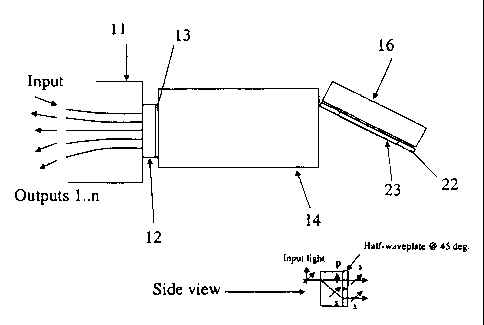Some of the information on this Web page has been provided by external sources. The Government of Canada is not responsible for the accuracy, reliability or currency of the information supplied by external sources. Users wishing to rely upon this information should consult directly with the source of the information. Content provided by external sources is not subject to official languages, privacy and accessibility requirements.
Any discrepancies in the text and image of the Claims and Abstract are due to differing posting times. Text of the Claims and Abstract are posted:
| (12) Patent: | (11) CA 2326088 |
|---|---|
| (54) English Title: | COMPACT DIFFRACTION GRATING BASED WDM DEMUX |
| (54) French Title: | DEMULTIPLEXEUR WDM A RESEAU DE DIFFRACTION COMPACT |
| Status: | Expired and beyond the Period of Reversal |
| (51) International Patent Classification (IPC): |
|
|---|---|
| (72) Inventors : |
|
| (73) Owners : |
|
| (71) Applicants : |
|
| (74) Agent: | |
| (74) Associate agent: | |
| (45) Issued: | 2006-01-24 |
| (22) Filed Date: | 2000-11-16 |
| (41) Open to Public Inspection: | 2001-06-22 |
| Examination requested: | 2002-07-22 |
| Availability of licence: | N/A |
| Dedicated to the Public: | N/A |
| (25) Language of filing: | English |
| Patent Cooperation Treaty (PCT): | No |
|---|
| (30) Application Priority Data: | ||||||
|---|---|---|---|---|---|---|
|
In the area of wavelength division multiplexing (WDM), the present invention
relates to a demultiplexer/multiplexer based on a diffraction grating, in
which a beam of
light is separated into two orthogonally polarized sub-beams prior to beam
collimation.
Due to the characteristics of the beam splitting crystal, parts of the sub-
beams overlap
resulting in portions of the sub-beams becoming improperly polarized. Too
alleviate the
errors cause thereby, an iris is placed over the diffraction grating to
eliminate the portions
of the light that have been polarized improperly.
Note: Claims are shown in the official language in which they were submitted.
Note: Descriptions are shown in the official language in which they were submitted.

2024-08-01:As part of the Next Generation Patents (NGP) transition, the Canadian Patents Database (CPD) now contains a more detailed Event History, which replicates the Event Log of our new back-office solution.
Please note that "Inactive:" events refers to events no longer in use in our new back-office solution.
For a clearer understanding of the status of the application/patent presented on this page, the site Disclaimer , as well as the definitions for Patent , Event History , Maintenance Fee and Payment History should be consulted.
| Description | Date |
|---|---|
| Revocation of Agent Requirements Determined Compliant | 2020-09-01 |
| Time Limit for Reversal Expired | 2010-11-16 |
| Inactive: Adhoc Request Documented | 2010-02-11 |
| Letter Sent | 2009-11-16 |
| Letter Sent | 2009-01-16 |
| Inactive: Office letter | 2008-12-02 |
| Grant by Issuance | 2006-01-24 |
| Inactive: Cover page published | 2006-01-23 |
| Pre-grant | 2005-11-10 |
| Inactive: Final fee received | 2005-11-10 |
| Notice of Allowance is Issued | 2005-10-03 |
| Letter Sent | 2005-10-03 |
| Notice of Allowance is Issued | 2005-10-03 |
| Inactive: Approved for allowance (AFA) | 2005-09-09 |
| Inactive: IPC assigned | 2004-12-03 |
| Inactive: IPC assigned | 2004-12-03 |
| Inactive: First IPC assigned | 2004-12-03 |
| Inactive: IPC assigned | 2004-12-03 |
| Inactive: Office letter | 2003-09-10 |
| Revocation of Agent Requirements Determined Compliant | 2003-09-10 |
| Inactive: Office letter | 2003-09-09 |
| Revocation of Agent Request | 2003-07-22 |
| Letter Sent | 2002-08-28 |
| Amendment Received - Voluntary Amendment | 2002-07-22 |
| Request for Examination Requirements Determined Compliant | 2002-07-22 |
| All Requirements for Examination Determined Compliant | 2002-07-22 |
| Request for Examination Received | 2002-07-22 |
| Application Published (Open to Public Inspection) | 2001-06-22 |
| Inactive: Cover page published | 2001-06-22 |
| Inactive: First IPC assigned | 2001-01-31 |
| Letter Sent | 2001-01-05 |
| Inactive: Filing certificate - No RFE (English) | 2001-01-05 |
| Filing Requirements Determined Compliant | 2001-01-05 |
| Inactive: Inventor deleted | 2001-01-02 |
| Application Received - Regular National | 2001-01-02 |
There is no abandonment history.
The last payment was received on 2005-10-27
Note : If the full payment has not been received on or before the date indicated, a further fee may be required which may be one of the following
Please refer to the CIPO Patent Fees web page to see all current fee amounts.
| Fee Type | Anniversary Year | Due Date | Paid Date |
|---|---|---|---|
| Application fee - standard | 2000-11-16 | ||
| Registration of a document | 2000-11-16 | ||
| Request for examination - standard | 2002-07-22 | ||
| MF (application, 2nd anniv.) - standard | 02 | 2002-11-18 | 2002-08-02 |
| MF (application, 3rd anniv.) - standard | 03 | 2003-11-17 | 2003-10-28 |
| MF (application, 4th anniv.) - standard | 04 | 2004-11-16 | 2004-10-21 |
| MF (application, 5th anniv.) - standard | 05 | 2005-11-16 | 2005-10-27 |
| Final fee - standard | 2005-11-10 | ||
| MF (patent, 6th anniv.) - standard | 2006-11-16 | 2006-10-30 | |
| MF (patent, 7th anniv.) - standard | 2007-11-16 | 2007-10-30 | |
| MF (patent, 8th anniv.) - standard | 2008-11-17 | 2008-11-17 |
Note: Records showing the ownership history in alphabetical order.
| Current Owners on Record |
|---|
| JDS UNIPHASE INC. |
| Past Owners on Record |
|---|
| THOMAS DUCELLIER |